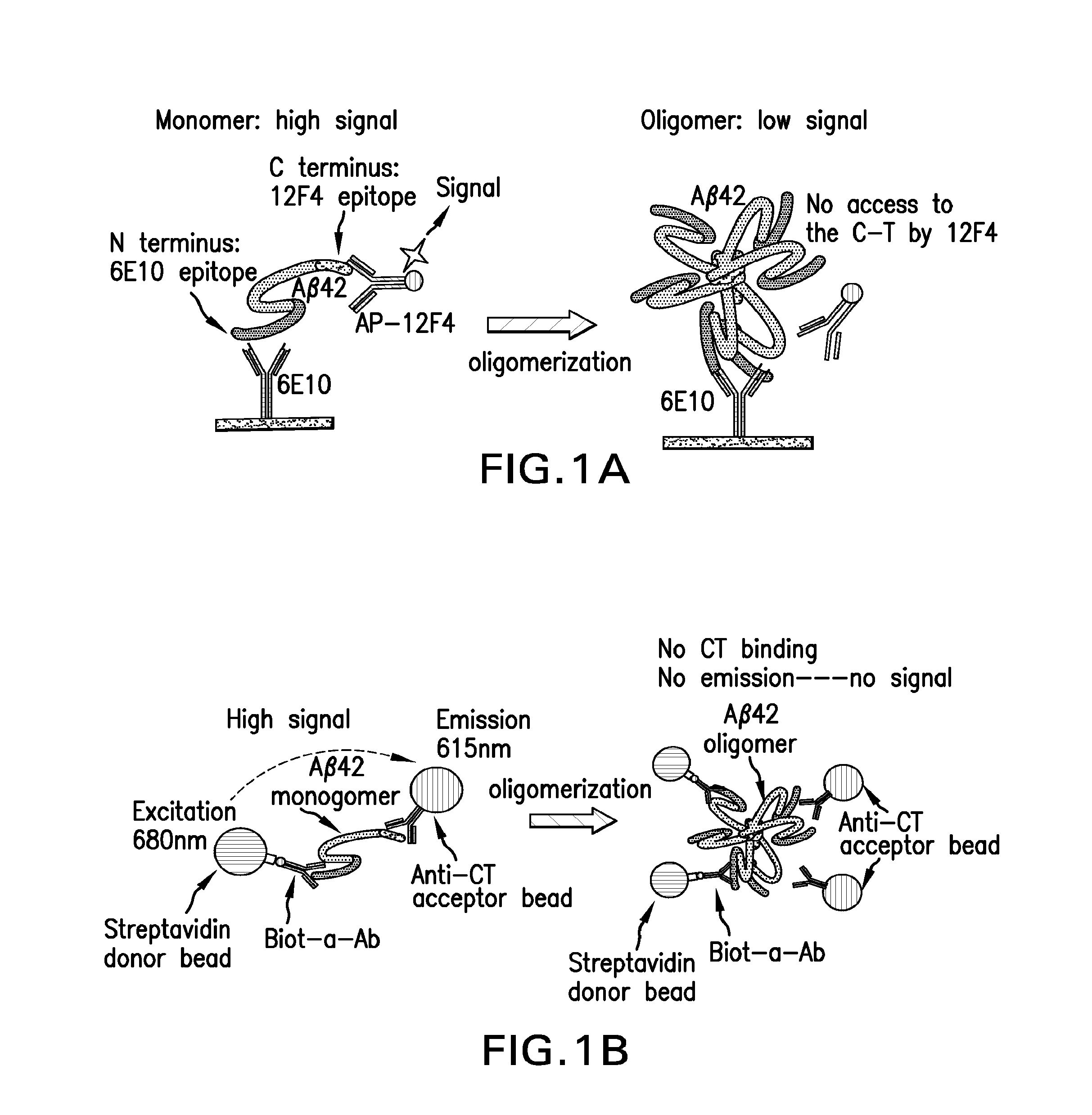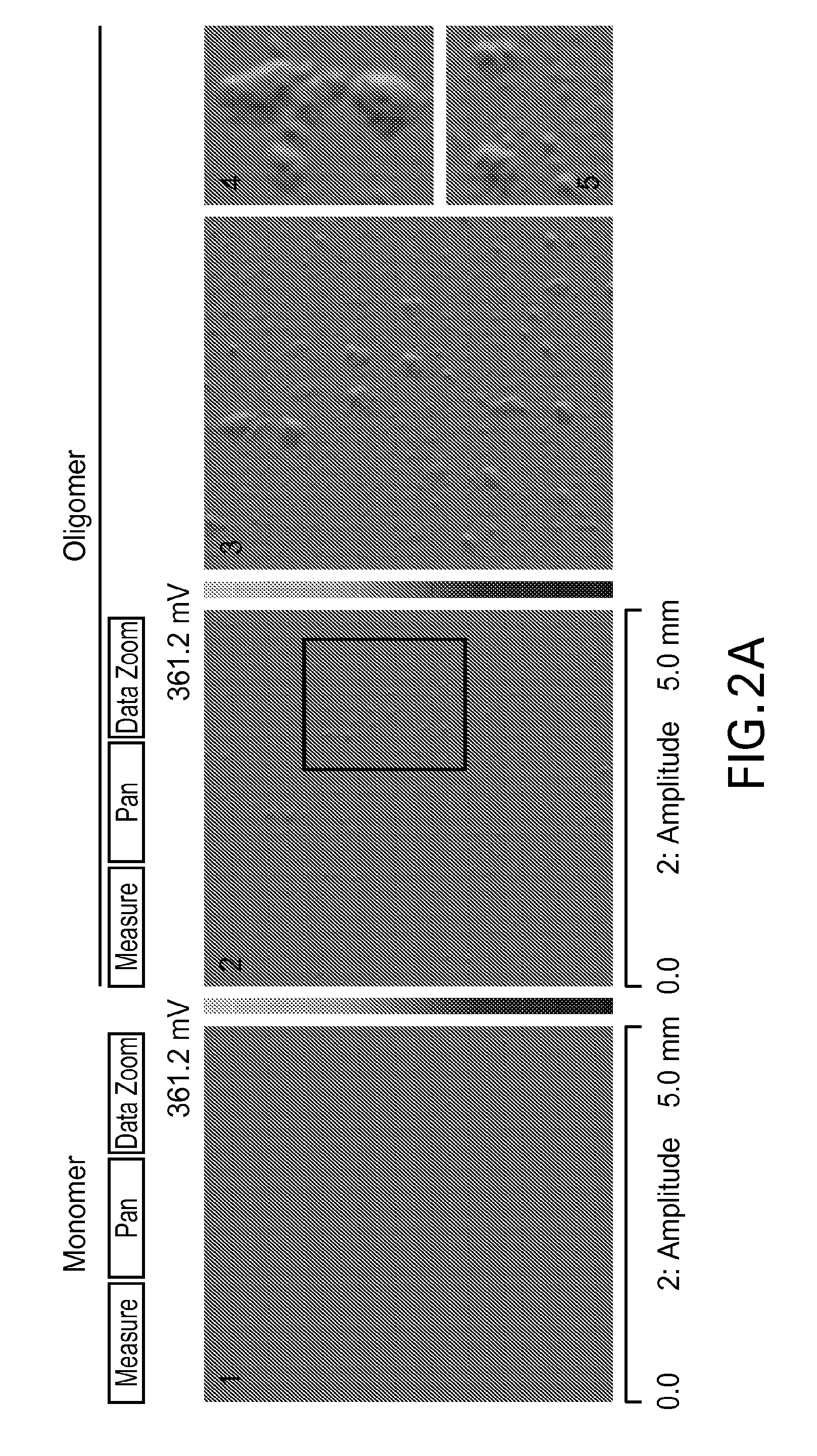Methods for identifying inhibitors of abeta42 oligomers
- Summary
- Abstract
- Description
- Claims
- Application Information
AI Technical Summary
Benefits of technology
Problems solved by technology
Method used
Image
Examples
example 1
Preparation of Aβ42 Oligomers
[0052]Nonbinding polypropylene tubes were used for handling A131-42. Synthetic human Aβ1-42, purchased from American Peptide Company (Sunnyvale, Calif.), was dissolved in 1,1,1,3,3,3,-hexafluoro-2-propanol (HFIP) (Sigma-Aldrich Corp., St. Louis, Mo.) to 1 mM and incubated at room temperature for 30 minutes to remove secondary structures of the peptide. Following aspiration of HFIP, the peptide was lyophilized in a vacuum concentrator (SpeedVac®, Thermo-Fisher Scientific, Waltham, Mass.) and stored at −80° C. until use. The HFIP dry film was dissolved in dimethyl sulfoxide (DMSO) (Sigma-Aldrich Corp., St. Louis, Mo.) to 1 mM to form a stock solution, which was aliquoted into small quantities (100 μl) and stored at −80° C. until used. To prepare the Aβ42 oligomers, 1 mM of the Aβ42 DMSO stock solution was diluted in 10× series in nonbinding polypropylene microtubes to 100 μM, 10 μM, and 1 μM, in a buffer (e.g. PBS) or in medium (e.g. Neurobasal).
[0053]To g...
example 2
Aβ42 Inhibitor Assays
[0054]A. Metastability
[0055]The effect of an Aβ oligomer inhibitor on the metastability of Aβ42 oligomers prepared according Example 1 was evaluated as follows. A sample of the 1 mM Aβ42 DMSO stock was diluted to 10 μM or 100 μM in PBS or Neurobasal (e.g., 10 μl of 1 mM Aβ42 DMSO stock to make 1 ml 10 μM solution or 100 μl A(342 DMSO stock to make 1 ml 100 μM solution). After incubation at 37° C., the diluted oligomer solutions were mixed with scyllo-inositol (SI), a naturally occurring plant sugar alcohol found most abundantly in the coconut palm, to make a final concentrations of 1 μM or 10 μM Aβ42 containing 10 mM SI. The non-compound control oligomer sample contained no SI. The mixtures were incubated on ice for two to three hours to allow establishment of new equilibrium (metastability) among Aβ42 species. The stabilized mixtures were then utilized in the immunoreactive assays.
[0056]B. Early Oligomerization
[0057]To test a compound's effect on inhibition of ...
example 3
Aβ42 C-Terminal (CT) Oligomer ELISA
[0058]An Aβ42 C-terminal (CT) oligomer assay was performed using an ELISA format as follows. Briefly, a 96-well black OptiPlate™ (PerkinElmer, Waltham, Mass.) was coated with (100 μl / well) 5 μg / ml of a capture antibody, 6E10, an antibody that recognizes an epitope in the N-terminal (NT) region of Aβ, prepared in a sodium bicarbonate buffer (Sigma-Aldrich Corp., St. Louis, Mo.) and incubated at 4° C. overnight. The plate was then blocked with 5% bovine serum BSA (Sigma-Aldrich Corp., St. Louis, Mo.) made in phosphate buffered saline containing 0.05% Tween 20 (Sigma-Aldrich Corp., St. Louis, Mo.) (PBST) for 10 to 12 hours. After rinsing the plate once with 1× PBST, Aβ42 oligomer or monomer samples were added to the plate (100 μl / well) and incubated at 4° C. overnight. After removal of unbound samples, the plate was washed with 1× PBST for six times. The plate was then incubated with 100 μl of a detection antibody, 12F4, an antibody that recognizes an...
PUM
 Login to View More
Login to View More Abstract
Description
Claims
Application Information
 Login to View More
Login to View More - R&D
- Intellectual Property
- Life Sciences
- Materials
- Tech Scout
- Unparalleled Data Quality
- Higher Quality Content
- 60% Fewer Hallucinations
Browse by: Latest US Patents, China's latest patents, Technical Efficacy Thesaurus, Application Domain, Technology Topic, Popular Technical Reports.
© 2025 PatSnap. All rights reserved.Legal|Privacy policy|Modern Slavery Act Transparency Statement|Sitemap|About US| Contact US: help@patsnap.com



